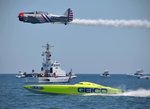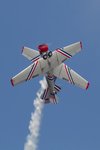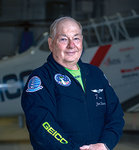



The roar of engines and feats of perilous precision flying keep audiences coming back to Jacksonville’s annual Sea and Sky Air Show. This year’s event, Oct. 26 and 27, is taking place in Jacksonville Beach and promises one of the best line-ups to date, including the U.S Army Golden Knights, the Blue Angels, the Air Force Red Tail Squadron P-15 demo commemorating the Tuskegee Airmen and the Miss GEICO Speedboat Race.
Pilot Jim Record is excited about this year’s show. Even after 27 years of flying with the GEICO Skytypers, being up in the air is something that never gets old for him. After all the long hours working around the clock and limited “actual” fly time, Record said being a pilot is just something you’re born to do.
“Even though you have a job to do, the pure beauty of flight is not lost on us,” Record said. “Sometimes it will get pushed back to the corner of your brain, but flying is one of those jobs that is in your blood.”
The GEICO Skytypers fly “taildragger warbirds,” used primarily during World War II as trainer aircraft. They are SNJ propeller planes that were able to perform all the maneuvers of a fighter plane on a 600-horsepower Pratt and Whitney engine. According to Record, the planes built in the era were the top of the line.
“World War II was the zenith of propeller driven fighters,” Record said. “The P-51 Mustang and similar planes were the best ever produced. Even today, when you go to the Reno Air Races in Nevada, the airplanes racing are P-51 Mustangs from 1944. Yeah, they are old technology, but as far as capability, they were as good as they got then.”
Hailing from the “Cradle of Aviation,” Long Island, Record started his own career serving as an IP in Formation, Gunnery and Carrier Landings with the Navy. His early interest in aviation was nurtured by his father, who flew in a bomber crew during World War II and supported him early on in his career. He has flown corporate jets, commercial airlines and served as a professor for Dowling in the College of Aviation before joining the Skytypers. With all his experience flying Boeing 747s, military trainers, carriers, Airbuses and propeller planes, Record said big or small, flying doesn’t vary too much.
“The beauty of flying is you fly the airplane and the basic rules are the same,” Record said. No matter how big the plane is, “You pull the stick forward and the houses on the ground get bigger and you pull the stick back and the houses on the ground get smaller.”
One would think that flying precision maneuvers in formation takes an extra set of “copilots,” but Record said the daredevil stunts are designed to look more dangerous from the ground than they actually are.
“It looks close because that's how we want you to look at it,” Record said. “In reality, we have what we call ‘outs.’ We have positions that we look at and safety margins and this and that. In other words, we can stop a maneuver and fly away to a safe place at any time.”
In addition to feats of daring, Record and his team also perform “Skytyping,” which is a form of sky writing that has been patented by the company. The method works 17 times faster than writing by ejecting an environmentally friendly, paraffin-based solution in the exhaust manifold that is connected through a formation from the team, rather than a singular plane. The message is spelled out in “dots” that can be seen from 15 miles away and is approximately the size of the Empire State Building. Skytyping is such a highly effective form of communicating a message that Record said it may have caused a few problems for couples lucky or unlucky enough to see it together.
“Strangely enough we do about a dozen or so marriage proposals a year,” Record said. He said one message once read: “Mary, will you marry me, John.” Then, “About eight or ten couples on the beach all jumped up. There were that many John and Marys,” he said.